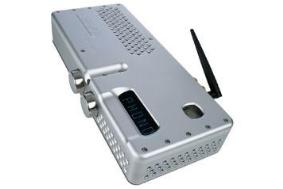What Hi-Fi? Verdict
Shows high-end hi-fi can combine fine build, ample features and great sounds in a small, stylish package
Pros
- +
High-quality built-in DAC
- +
powerful and insightful sound
- +
stunning build and finish
- +
tiny size
Cons
- -
Short on rhythmic precision and dynamic subtlety
Why you can trust What Hi-Fi?
The high-end of the hi-fi market is a deeply conservative sector. It's a market that took well over a decade to embrace CD as an acceptable source, so it comes as no surprise to see computer-based audio struggling to gain credibility.
It's a refreshing change, then, to find a well-established high-end brand such as Chord Electronics treat computer-based audio with the respect it deserves.
Chord's forward-thinking outlook came to light a couple of years ago when it introduced a pair of stand-alone digital-to-analogue converters capable of accepting USB inputs and Bluetooth signals. Laptops and phones became legitimate hi-fi sources in an instant.
Now the company has integrated such DAC circuitry into its one-box amps. There are two models
– the CPM2800 and this, the pocket-sized Cyan Click HP.
Like a piece of jewellery
The initials HP stand for ‘high power'. Our review sample is the 100-Watt-per-channel version. There is a half-power option that saves £340, but it's not worth the compromise, we'd say.
The Cyan Click is closer to fine jewellery in terms of finish and cosmetics than any rival we can think of. The quality of the casework is stunning, and when you combine that with the unit's intricate machining (inside and out) and high-quality circuitry, that hefty price tag starts to make sense.
It runs hot, as most things that deliver high power from a small package tend to, so make sure you leave plenty of ventilation.
The small size – 6 x 34 x 14cm – also limits the space for connections. There are just two analogue inputs – one balanced XLR and the other a pair of RCAs.
Going digital gives extra options in the form of BNC, USB and Bluetooth, alongside the more conventional optical connection.
Niggles eclipsed by fine performance
Our only functional complaints concern the generic remote that Chord supplies – there are too many redundant buttons – and the Cyan Click's cramped rear panel, which is a bit of a pain to use when there are multiple connections to be made.
Performance? On the whole it's good – very good in some areas. The DAC circuitry is newly developed and works well, providing great results through the USB and Bluetooth connections.
Our Samsung laptop has rarely sounded so good, delivering a fine level of transparency and dynamics with WAV files of music as wide-ranging as that of The XX and Florence and the Machine to 320kbps versions of The Road OST.
As you'd expect, the WAV files sounded markedly better and would be well worth using (despite the larger file sizes) if you want to make the most of the Click's abilities.
With CD, our reference Naim CDS3/555ps combination shows the Chord capable of a surprisingly large scale of sound, considering how small it is.
Decent levels of volume
There's plenty of authority and drive and, as the 100-Watt-per-channel power output suggests, decent volume levels.
A spin of Beethoven's 5th Symphony shows a fine level of insight and a convincing tonal balance. The sound staging is precise and expansive and the higher frequencies tread a nicely judged path between refinement and bite.
Switch to the likes of The Magnetic Fields' Realism or Massive Attack's Atlas Air and the Chord continues to impress with its precision and agility, although a few chinks emerge, too.
Large-scale dynamic transients (though good) don't quite hit with the force we'd hope for at this price level. Equally, low-level nuances are sometimes glossed over and rhythmic drive could be more enthusiastically handled, too.
We can't help but applaud Chord's attitude to new technology.
With the Cyan Click HP, the company has produced an astonishingly well-built product that aims to satisfy audiophiles without alienating the style crowd. On the whole, it succeeds. And that isn't an easy thing to do.
See all our amplifier Best Buys
Follow whathifi.com on Twitter
What Hi-Fi?, founded in 1976, is the world's leading independent guide to buying and owning hi-fi and home entertainment products. Our comprehensive tests help you buy the very best for your money, with our advice sections giving you step-by-step information on how to get even more from your music and movies. Everything is tested by our dedicated team of in-house reviewers in our custom-built test rooms in London, Reading and Bath. Our coveted five-star rating and Awards are recognised all over the world as the ultimate seal of approval, so you can buy with absolute confidence.


